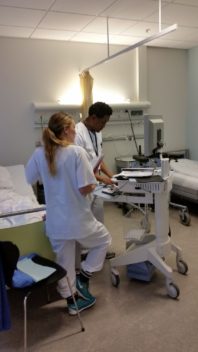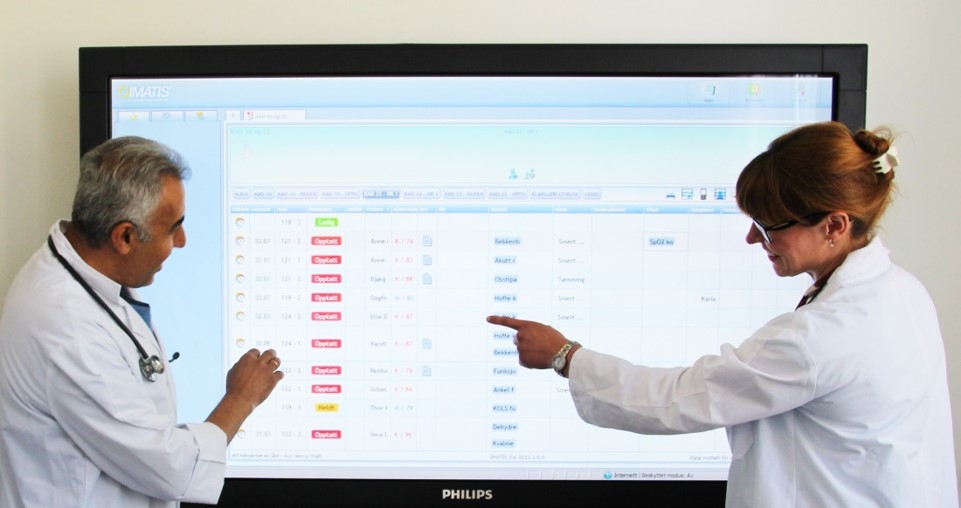Millions saved when health professionals requisition IT services
Millions are saved and job satisfaction boosted when doctors and nurses are actively involved in selecting the IT systems they need to rationalise their day-to-day routines.
Facts about SamKAD
The SamKAD project (Coordination and Task Support for a Municipal Acute Day Bed Unit) was launched in 2014 and completed in the summer of 2017. It was initiated because Norwegian municipalities were required by law to establish by 2016 acute day bed units (the so-called KAD initiative) as a means of relieving pressure on hospitals. Oslo municipality established one of the first KAD services in Norway in 2013 at what was then known as Aker University Hospital, now Aker helsearena (Aker Health Arena).
The project has been carried out under the auspices of Oslo municipality’s Health Services Department. SINTEF has acted as research and innovation partner, and Imatis AS and CSAM Health AS as private sector partners. Oslo and Akershus University College of Applied Sciences has also participated as a research partner. SamKAD is defined as a public sector innovation project and is funded in part by the Regional Research Funding Agency Hovedstadsfondet (Capital City Fund).
Innovation and research during this project has led to the following results:
• Improved work processes during patient pathways.
• Improved communication and information sharing during patient pathways.
• The development of new or modified management approaches.
• The establishment of new organisational structures for service provision and work processes.
• Modified working conditions, in that tasks are now carried out during new phases of the patient pathway.
• Changes in skills requirements.
• Improved service evaluation options.
“We needed assistance in finding a technical solution and effective organisational approaches so that we could maintain our maximum three-day hospitalisation target”, says Project Manager Marit Røed Halvorsen at Oslo municipality’s Health Services Department. “Our aim was to meet ambitious targets, and we started from scratch”, she says. The municipality contacted SINTEF, and together they applied for funding for a research and innovation project. The result was the SamKAD project, launched in 2014. (SamKAD is a Norwegian construction for ‘Coordination and Task Support for a Municipal Acute Day Bed Unit’).
The researchers created a system incorporating user-involvement in its development. Three nurses and a doctor have been working part-time to adapt the system to their day-to-day clinical routines. They have also trained other employees.
Millions in savings
The aim of the project was to see how organisation and procedures could be improved by using new and innovative systems that promoted more efficient patient pathways. User surveys show that both employees and patients are very pleased with the result. The data on clinical efficiency are also positive in that there was a 20 per cent reduction in personnel costs per KAD patient in the period 2014 to 2016.
“From 2015 to 2016 the unit has produced efficiency improvements amounting to approx. NOK 3.7 million”, says SINTEF researcher Tarald Rohde, who has been following the project’s cost-efficiency. “We believe that these efficiency improvements are the result of the digital clinical logistics system IMATIS, combined with organisational restructuring. Moreover, we also achieve certain economies of scale, as well as building experience in our administration of the KAD system”, he says. The value of greater patient safety and better patient care is a bonus.
Real-time information
The company Imatis AS has supplied the technology.
“Before the changes we had an inefficient and outdated patient records system”, says Halvorsen. “Now, all the information is entered into a digital work interface that allows everyone to see what’s happening in real-time. We admit between 20 and 25 new patients each day and discharge about the same number. This process requires reliable information and efficient tools”, she says.
The system is developed in such a way that patient pathway information is available to doctors, nurses and auxiliary nursing staff on a variety of interfaces, including mobile phones, iPads, PCs and big screens. The same applies to service functions such as cleaning and food orders, which are services provided by external suppliers.

Picture caption: A mobile workstation makes all available information about a patient accessible to doctors and nurses during their rounds. Photo: Marit Røed Halvorsen.
The system has resulted in the rationalisation of shift changes, morning meetings, doctors’ rounds and previsits. This frees employees to focus on important tasks and effective patient safety.
“From our point of view, it’s important to be able to offer a system with adequate flexibility”, says Imatis CEO Morten Andresen. “It can be used by many Norwegian and overseas clients because it can be adapted to local needs and organisational structures”, he says.
Understanding employees’ needs
“What is important when introducing new technology in the health sector?”
“It’s all about understanding the needs of employees and applying this understanding in the context of patients’ needs”, says researcher Dag Ausen, who has been heading SINTEF’s work in connection with this project. “Many people think that once the technology has been commissioned the job is all over. In fact, innovation is needed all the time. We have to work actively with the technology and make adaptations as we go along”, he says.
The unique aspect of the project is that the employees themselves have participated in the introduction of the digital system. Project Manager Halvorsen, who is a trained nurse, is not aware of this having happened before in Norway
“It is we, the users, who have designed the system, and developed it over time”, she says. “With training from the supplier, we’ve learned how to create and configure app systems, and we’ve achieved significant results”, says Halvorsen proudly.
From teething problems to a 24-hour schedule
Before the technical and organisational systems developed as part of the SamKAD project were selected, a cross-disciplinary team of researchers spent a lot of time assessing workflows and bottlenecks, as well as needs. After one year in operation a system assessment was made, and the results weren’t all that encouraging. Among other things, deficiencies were identified in work procedures and communication, as well as high levels of stress among health personnel and major problems linked to coordination.
The problem facing KAD was the rapid growth in the number of beds, from 20 to 72. Because patients were only admitted for a short time, it was difficult to obtain a satisfactory overview of admissions and discharges, information about patients’ whereabouts, and what treatments and care they needed.
The situation was quickly remedied by, among other things, the introduction of a 24-hour schedule that ensured that all tasks were identified on time. Responsibilities and task levels were based on a 24-hour cycle. This contributed to better organisation and predictability.
“In the past, we had a problem because some nurses were allocated patients that required high levels of care, while others were given those that were less demanding”, says Halvorsen. “But the 24-hour schedule has enabled us to spread the work load more evenly among the nurses”, she says.
Hard won benefits
Ausen believes that the collaboration between researchers, the municipality, and the system supplier has been unique. Moreover, the project demonstrates the value and power of introducing digital systems in combination with changes to organisational structures and work processes.
“When you purchase an ICT system, this doesn’t always automatically result in better and more efficient services”, he says. “The benefits have to be hard won. “It’s up to the organisation to make effective use of the toolbox that the technology offers”, he says.
“A result as good as that which we are seeing in the KAD system in Oslo isn’t something that can be researched to completion in advance”, he continues. “An action research project has been carried out in which we have recognised a need for changes, and we’ve carried out adaptations during the process”, says Ausen.
Rohde has another explanation for the success of the project.
“I’ve seen many examples in which technical systems have been more or less forced on employees”, he says. The doctors taking part in the SamKAD project were sceptical at first before they understood how much time they would be saving. If the systems are perceived as making a positive contribution to their work, then they will be used”, he says.





